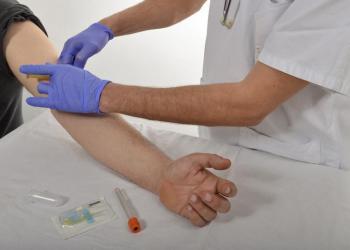
DUI Blood Draws and Implied vs. Express Consent, a Complex Issue
- Blood draws from a DUI suspect may be performed only after obtaining either a search warrant, a valid express consent, or under exigent circumstances with probable cause.
- The Vehicle Code’s implied consent provisions under V.C. § 23612(a)(5) do not constitute an express consent.
- A DUI suspect being unconscious, by itself, does not necessarily provide an exigent circumstance allowing for a warrantless blood draw.
Defendant was involved in a fatal car crash on March 25, 2018, at around 11:30 p.m. Responding officers found a Dodge Charger upside down in the roadway just north of the intersection of Ash Street and El Norte Parkway in Escondido. (Irrelevant fact #1: This is about two miles from where I lived for some 20 years of my 28-year tenure as a San Diego Deputy D.A.) Defendant—apparently “uninjured but shaken”—admitted to officers that he had been the driver of the Charger. A damaged second vehicle—a Ford Mustang—was in the front yard of a residence immediately adjacent to the intersection. In the Mustang were two individuals; one deceased and the other—a 15-year-old boy—seriously injured. The investigating officer contacted defendant at the scene and although not detecting any overt signs or symptoms that he might be under the influence of alcohol or drugs, he administered a so-called “horizontal gaze nystagmus field sobriety test.” The officer noted a “just a faint jerking in (the defendant’s) eyes, at the extremes.” (Per footnote 4: “Nystagmus is an involuntary rapid movement of the eyeball, which may be horizontal, vertical, or rotary. . . . An inability of the eyes to maintain visual fixation as they are turned from side to side [in other words, jerking or bouncing] is known as . . . HGN. . . . Some investigators believe alcohol intoxication increases the frequency and amplitude of HGN and causes HGN to occur at a smaller angle of deviation from the forward direction.” See People v. Leahy (1994) 8 Cal.4th 587, 592.) There was some ambiguous evidence from witnesses at the scene indicating that defendant, driving too fast and recklessly, may have blown the red light at that intersection, T-boning the Mustang as a result. Defendant was transported to the hospital to get checked out while the officer completed his investigation at the scene. The officer—at least at that time—“drew no conclusion regarding fault for this incident, and did not form an opinion whether the traffic light for (the defendant) was red, yellow, or green . . . .” After completing his on-scene investigation (at about 12:14 a.m.), the officer went to the hospital to further interview defendant. The officer arrived at the hospital at about 12:45 a.m.; 75 minutes after the collision. Contacting defendant while nurses “periodically attended to” him, the officer could smell an odor of alcohol emanating from him. When asked, defendant admitted to drinking “a beer” earlier in the day. At 1:00 a.m. (now an hour and a half after the collision), the officer had the defendant blow into a “preliminary alcohol screening (‘PAS’) device.” (This, if you don’t already know it, is [per fn. 7] “a portable mini breathalyzer.” It is recognized, however, that this test does not yield “evidence-grade alcohol concentration results.” See Birchfield v. North Dakota (2016) 579 U.S. 438, 487. Its results, therefore, are not admissible in court.) Defendant, however, could not—or would not—provide a breath sample sufficient for the PAS device to operate automatically and give a blood alcohol readout. So the investigator was forced to revert to a technique called a “manual trap.” This involves the officer pressing a button on the device making it capture and test a subject’s breath sample even when that sample itself is insufficient to trigger the device’s automated features. Per the investigator in his later testimony, using a manual trap typically yields a lower blood alcohol result than the normal, automatic method. Defendant’s PAS results came out at 0.037 and 0.039 blood alcohol concentration (“BAC”); insufficient to show by itself that defendant was under the influence of alcohol for purposes of driving a motor vehicle. Recognizing how useless this test would later be in court, the officer told defendant that he wanted to get a blood sample. Defendant, however, conveniently stopped responding verbally to the officer, closed his eyes, and seemed to be oblivious to anything that was said to him. The officer later testified that he could not tell whether defendant was asleep, unconscious, or just ignoring him. Concerned that defendant might be moved to another part of the hospital for treatment, the officer arranged for a phlebotomist (who was 30 minutes away) to take a sample of defendant’s blood. This was finally accomplished at 1:57 a.m., it being noted that defendant did not physically react to the insertion of the needle. The time was almost two and a half hours after the collision. This blood test revealed a 0.05 BAC with the presence of cocaine and THC (i.e., “tetrahydrocannabinol;” the psychoactive chemical in marijuana “that causes the ‘high’ associated with its use.”) being noted. The officer, of course, was not aware of the results of this test result while conducting his investigation at the hospital. Defendant, therefore, was never formally arrested. He was later charged by complaint in state court with two alcohol related vehicular manslaughter counts (the second victim having apparently died from his injuries) under P.C. § 191.5(a); i.e., Gross Vehicular Manslaughter. Defendant filed a motion to suppress the BAC results. This motion was granted when the People conceded that the officer should have obtained a search warrant before taking a blood sample. The People then amended the complaint to two non-alcohol related vehicular manslaughter violations pursuant to P.C. § 192(c)(1)(11), and a reckless driving charge. While pending trial, the United States Supreme Court decided the case of Mitchell v. Wisconsin (June 27, 2019) 588 U.S.__, __ [139 S.Ct. 2525]. Mitchell held (at pg. 2539) that “when police have probable cause to believe a person has committed a drunk-driving offense and the driver’s unconsciousness or stupor requires him to be taken to the hospital or similar facility before police have a reasonable opportunity to administer a standard evidentiary breath test, they may almost always order a warrantless blood test to measure the driver's BAC without offending the Fourth Amendment.” (Italics added.) With this apparent change in the law, the People moved for a reconsideration of the previously-granted suppression motion. The officer testified at two subsequent hearings that with the PAS test results, and the other information he had, he felt like he had probable cause to obtain a search warrant for defendant’s blood but that exigent circumstances prevented him from doing so. The officer’s reasoning was that getting the warrant would have created substantial delays primarily because he was the only officer at the hospital with the other officers still investigating the scene, he did not have the proper paperwork with which to get a warrant, and he was concerned that defendant might be made unavailable to him by the hospital staff. The trial court denied defendant’s suppression motion this time, finding that Mitchell applied and that exigent circumstances allowed for the warrantless blood draw. Defendant subsequently pled guilty and appealed.





